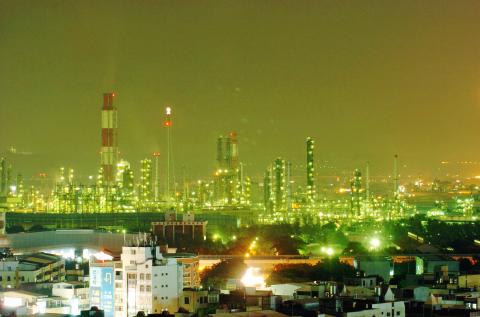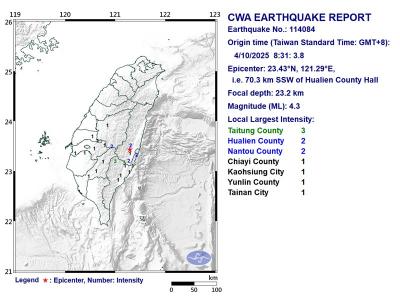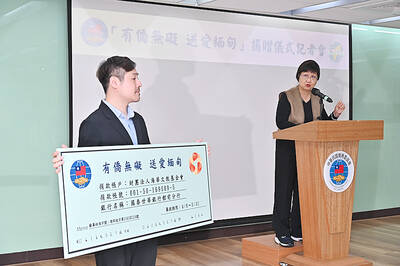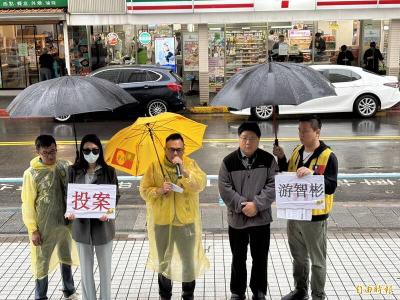Greater Kaohsiung has served as a hub for the petrochemical industry since the Japanese colonial era.
The city’s local industry employs 35,000 workers and is home to multiple petrochemical parks such as the state-run CPC Corp, Taiwan’s (CPC) Kaohsiung Refinery Plant, its Dalin (大林) Township Refinery Plant, the Dafa Industrial Area, the Linyuan (林園) Petrochemical Area, the Renwu (仁武) Petrochemical Industial Area and the Dashe (大社) Petrochemical Industrial Area.
The beginnings of the municipality’s petrochemical industry can be traced to 1936, when the former Japanese Imperial Navy established a fuel plant in what is now Nanzih District’s (楠梓) Houjin Township (後勁) to refine crude oil and fuel its fleet.

Photo: Chang Chung-yi, Taipei Time
After World War II ended in 1946, the then-Chinese Nationalist Party (KMT) government took over the plant, expanded on the Japanese-built infrastructure and refashioned it into CPC’s Kaohsiung fuel refinery.
In 1971, the plant expanded to include CPC’s first and second naphtha crackers, prompting other petrochemical giants to also set up facilities near Kaohsiung in Renwu and Dashe districts. Companies that have invested in these areas include the Formosa Plastics Group, Nanya Technology, USI Corp, Asia Polymer Corp, Taita Chemical Co and China Petrochemical Development Corp.
Currently, CPC’s Kaohsiung fuel refinery has 1,700 employees and churns out 200,000 barrels of oil a day.
However, its fifth naphtha cracker is facing an impending relocation and has been trying to boost its production quota to compensate for the period when it will not be operating during the move. The Renda (仁大) Industrial Area and more than 10 companies are to be impacted by the relocation, which could cost 2,500 workers their jobs.
The concentration of the petro-chemical industry in Greater Kaohsiung has prompted the saying: “If anything explodes at CPC’s plant, it would level Kaohsiung.”
However, prior to the pipeline explosions in the city’s Cianjhen (前鎮) and Lingya (苓雅) districts late on Thursday night and early on Friday morning, the expression had been said only in jest.
After seeing how a propene leak in a pipeline running underneath the middle of those districts wreaked massive damage, civic groups and academics are beginning to worry about Greater Kaohsiung’s status as a petrochemical hub.
As of 4pm yesterday, 28 people, including four firefighters, have been confirmed dead in the blasts, with two firemen still missing and 302 people reported as injured, according to figures compiled by the Central Disaster Emergency Operation Center.
Citizen of the Earth, Taiwan executive director Lee Ken-cheng (李根政) said that the network of pipes carrying petrochemical substances under the city is too dense, adding that some pipelines were even connected to one other.
After four decades in use, the pipes are all outdated, making them akin to dud bombs, Lee said.
Chang Jui-ren (張瑞仁), director of the Professional Geotechnical Engineers Association’s Kaohsiung-Pingtung Office, said the gas companies should have been more worried than the government about leaks depressurizing the flow of gas, adding that no one had a clue about which pipe was malfunctioning.
“How can the public feel safe with these people in charge of the pipelines running underneath them?” Chang asked.
Yang Ping-tsang (楊秉蒼), a professor at Cheng Shiu University’s department of civil engineering, said the problem lay in the nation’s lack of laws governing the oversight of pipelines’ security, so local governments build modern urban cities with no visible pipelines by putting them underground, which means no one knows what state they are in.
Former Kaohsiung Professional Civil Engineers Association president Ou Liang-kui (歐良規) said that despite recent fears, the continued security and transformation Greater Kaohsiung must not exclude the petrochemical industry.
The Greater Kaohsiung City Government’s plan for the “New Asia Bay Area” happens to pass over Chenggong Road, under which run oil and petrochemical pipelines, Ou said.
If anything were to happen to that line, the “cream of the cream” of Greater Kaohsiung may be subject to explosion, Ou said.
Though the petrochemical industry provides for tens of thousands of families, a recent string of safety incidents including the blasts led the director of the city government’s Economic Development Bureau, Tseng Wen-sheng (曾文生), to say that while the city welcomes investors, it also hopes they will uphold their social responsibilities.

Taiwan is stepping up plans to create self-sufficient supply chains for combat drones and increase foreign orders from the US to counter China’s numerical superiority, a defense official said on Saturday. Commenting on condition of anonymity, the official said the nation’s armed forces are in agreement with US Admiral Samuel Paparo’s assessment that Taiwan’s military must be prepared to turn the nation’s waters into a “hellscape” for the Chinese People’s Liberation Army (PLA). Paparo, the commander of the US Indo-Pacific Command, reiterated the concept during a Congressional hearing in Washington on Wednesday. He first coined the term in a security conference last

A magnitude 4.3 earthquake struck eastern Taiwan's Hualien County at 8:31am today, according to the Central Weather Administration (CWA). The epicenter of the temblor was located in Hualien County, about 70.3 kilometers south southwest of Hualien County Hall, at a depth of 23.2km, according to the administration. There were no immediate reports of damage resulting from the quake. The earthquake's intensity, which gauges the actual effect of a temblor, was highest in Taitung County, where it measured 3 on Taiwan's 7-tier intensity scale. The quake also measured an intensity of 2 in Hualien and Nantou counties, the CWA said.

The Overseas Community Affairs Council (OCAC) yesterday announced a fundraising campaign to support survivors of the magnitude 7.7 earthquake that struck Myanmar on March 28, with two prayer events scheduled in Taipei and Taichung later this week. “While initial rescue operations have concluded [in Myanmar], many survivors are now facing increasingly difficult living conditions,” OCAC Minister Hsu Chia-ching (徐佳青) told a news conference in Taipei. The fundraising campaign, which runs through May 31, is focused on supporting the reconstruction of damaged overseas compatriot schools, assisting students from Myanmar in Taiwan, and providing essential items, such as drinking water, food and medical supplies,

New Party Deputy Secretary-General You Chih-pin (游智彬) this morning went to the National Immigration Agency (NIA) to “turn himself in” after being notified that he had failed to provide proof of having renounced his Chinese household registration. He was one of more than 10,000 naturalized Taiwanese citizens from China who were informed by the NIA that their Taiwanese citizenship might be revoked if they fail to provide the proof in three months, people familiar with the matter said. You said he has proof that he had renounced his Chinese household registration and demanded the NIA provide proof that he still had Chinese